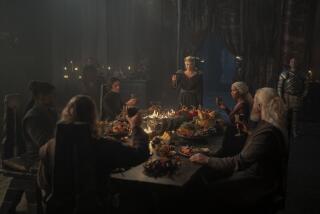‘THE DRAGON’S’ REAL PEOPLE
- Share via
Since you seem to be offering your pages to an attack upon “Year of the Dragon” based upon the sure-fire charges that the picture is racist/sexist (no one seems to say the picture is lousy) without any dissent (“Chinese-Americans React to ‘The Dragon,’ ” and Readers Comments, Sept. 1), I feel compelled to offer a defense.
I have seen the movie. I think it is one of the better films I have seen and I doubt that most of the anti-movie protesters have seen it.
One of the charges being made is that the picture shows Chinese (Asians) in an unattractive, non-positive and stereotypical light. Before examining the charges, I might point out that almost every weekend our TV screens show us Bruce Li (Lee) or one of his Asian clones in hour after boring hour of mindless brutality in films without one single protest.
So why “Year of the Dragon?”
“Year of the Dragon” shows us a lot of very real people. Many of these people are among the worst slumlords in the United States. We are shown very poor and voiceless Asians living like animals, sometimes 30 to a filthy room. The picture states that these conditions exist in part because the slumlords (who are quite well off, thank you) pay off the white bureaucrats and politicians.
The movie also shows a few scenes of horrible worker exploitation. A sewing machine-strewn sweatshop owned by a wealthy criminal, a soya-bean crushing facility (I think) which is run by a very decent guy who seems to be violating every known labor law in the free world (where the hell are the protesters outside his plant?), and a kitchen in a restaurant that is in violation of every health and safety code ever enacted in the United States. The restaurant is run by a criminal who pays off the whites.
In light of the forgoing, it can be truthfully said that neither whites nor Asians are shown in a very “positive” light in this picture. And these kinds of people shouldn’t be.
But this is a dramatic story . It pushes almost every single character to the brink of where he or she won’t compromise their “principles” any further, and so they decide to fight. None of us looks too good when we get pushed that far. Race has nothing to do with it.
As for the film being sexist: The cop’s wife is not a raving beauty. But we see a real nice lady who is married to a guy who is not Mr. Ideal Husband, and she has been pushed to her limit. So she decides to fight him and doesn’t look too hot when she does it. Is that sexist? Why? Because she doesn’t win by a knockout?
The woman playing the TV reporter (a lousy actress, I agree) is a person who exploits other people to earn a living and, like many TV reporters, she tries to create news sometimes. The cop who exploits people all the time to earn his living strikes a mutual exploitation pact with her. A story of two nice but not-so-nice people.
Again, so what? If the cop as portrayed in the film hadn’t found her he’d have found someone else. That’s what he does. After all, he also finds two nuns whom he employs as slave labor. Is this sexist? This cop exploits all relationships for his own ends, with women and men of all races (perhaps this makes him a liberal?).
I now ask an obvious question: Who do you think is picketing and protesting this film? The poor and mostly illiterate victims of the slumlords and sweatshops after completing their 16-hour days?
Or could it be the agents of the slumlords, sweatshops and Triads who would like this film depiction of a part of their lives to disappear; or failing that, cause it to be tarred as racist and sexist trash, something not to be considered?
I think The Times owes it to itself to really look at the people who are protesting against the truths in this film and find out their economic connections to the exploiters of human beings that this fine film details.
We should all face the facts that “Year of the Dragon” addresses. There are Asian gangs in this country. They are corrupting society as much as the Italian, black, Mexican or any other criminal syndicate. When we see some of the real evils depicted in this picture being talked about in The Times and elsewhere, perhaps this very good film can be put into perspective.
It’s time The Times spoke for the real victims: the kids on dope, the dead gang victims, the slave workers and the honest business people who can’t compete against criminal enterprises paying slave wages to helpless people.
HOWARD VEIT
Chatsworth
More to Read
Only good movies
Get the Indie Focus newsletter, Mark Olsen's weekly guide to the world of cinema.
You may occasionally receive promotional content from the Los Angeles Times.










